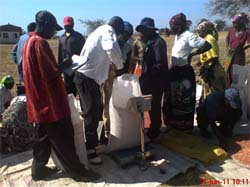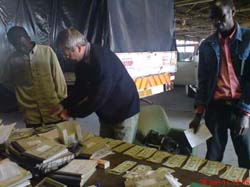It had become a norm for smallholder farmers in Mudzi district that after harvesting their groundnuts they would struggle to get a remunerative market for their produce. In most cases, the farmers ended up selling their produce at very low prices to opportunistic buyers. The farmers were not organized implying that they lacked the capacity to negotiate with the buyers or store their produce until prices would become favorable. In addition, the farmers also did not have access to value addition options. This lack of organization meant that the farmers lacked access to market information (especially on prices), access to remunerative distant markets and knowledge on how they could do their farming as a business. However, the 2010/11 season brought a turning point to the farmers in Mudzi’s Ward 12, one of the wards where the N2Africa project is working.
 |
 |
|
Figure 1:Time to secure their load: RGEs tighten the ropes which secured their groundnuts. [Pictured by Byron Zamasiya] |
Figure 2:Time to pocket proceeds: The sales committee watch Mark from Monakem counting their payment [pictured by Byron Zamasiya]. |
The close collaboration between the IFAD and N2Africa teams resulted in the establishment of 10 collective marketing groups (Rural Group Enterprise, RGEs) in ward 12 in March 2011. A total of 10 RGEs with a minimum membership of 10 N2Africa farmers were formed. This arrangement polarized farmers as some (the pessimists) thought CIAT was the buyer while others (optimists) were willing to give it a try. Eventually when the formation of the groups materialized, some RGE members had already started disposing their unshelled groundnuts to the Grain Marketing Board (GMB) at $400/ton. This is despite the fact that the GMB is traditionally known for delivery payments very late. For instance, in the previous season, some farmers who delivered their produce to GMB did not get their payments till today. Furthermore, the RGEs felt that the use of the spring balancing scale was very suspicious as it could be tampered with resulting in underweights.
The project team facilitated a link between the RGEs and the market through timely provision of market information on prices and trading terms of most buyers in the capital Harare. CIAT also provided the RGEs with a digital balancing scale, empty bags and twine. Based on the information on market prices and trade terms, the RGEs agreed to shell their nuts. They chose to sell their nuts to Monakem Investments which was offering a spot price of $750/ton upon delivery in Harare. The RGEs concurred to bring at least one 50kg bag of shelled groundnuts per household. This would translate to 5 tons for the 10 RGEs. During a meeting on the 27th of June at Makanjera Business Centre in Ward 12, the RGEs established two committees namely a quality control and marketing committee. The quality control committee worked on assessing the quality and grade of the nuts before they were weighed and bagged. On the other hand, the marketing committee worked on transport arrangements. They hired a lorry at a cost of $150 to ferry their produce to Harare which lies 238 km away. On the 28th of June, they finally sold 2.945 tons to Monakem Investments in Harare. The project team members helped the farmers to negotiate with Monakem to raise their price to $780/ton since their nuts were of a high grade.
Monakem requires 2 tons of nuts per day implying that there is a ready demand for groundnuts from the RGEs. Sharing of sales proceeds was done on the 29th of June during a feedback meeting. The RGEs agreed that their major obstacle in their pursuit of marketing was lack of knowledge on marketing, negotiation skills and lack of organization. For the 2011/12 season, the RGEs have pledged to commit more land to groundnuts as they are now assured of markets.
Byron Zamasiya and Isaac Chabata
